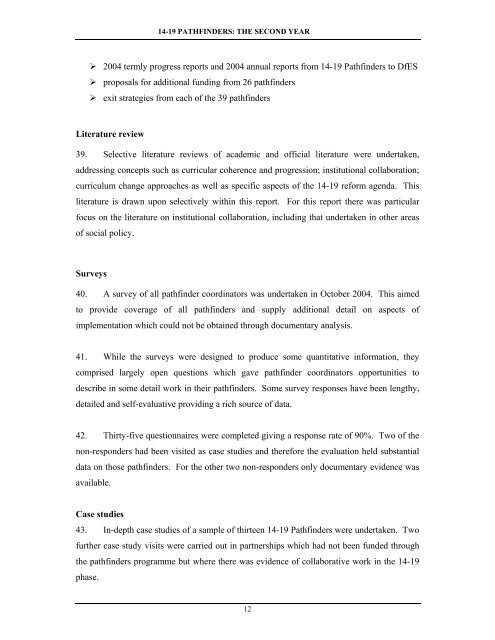Collaborative Approaches to 14-19 Provision - Communities and ...
Collaborative Approaches to 14-19 Provision - Communities and ...
Collaborative Approaches to 14-19 Provision - Communities and ...
- No tags were found...
Create successful ePaper yourself
Turn your PDF publications into a flip-book with our unique Google optimized e-Paper software.
<strong>14</strong>-<strong>19</strong> PATHFINDERS: THE SECOND YEAR‣ 2004 termly progress reports <strong>and</strong> 2004 annual reports from <strong>14</strong>-<strong>19</strong> Pathfinders <strong>to</strong> DfES‣ proposals for additional funding from 26 pathfinders‣ exit strategies from each of the 39 pathfindersLiterature review39. Selective literature reviews of academic <strong>and</strong> official literature were undertaken,addressing concepts such as curricular coherence <strong>and</strong> progression; institutional collaboration;curriculum change approaches as well as specific aspects of the <strong>14</strong>-<strong>19</strong> reform agenda. Thisliterature is drawn upon selectively within this report. For this report there was particularfocus on the literature on institutional collaboration, including that undertaken in other areasof social policy.Surveys40. A survey of all pathfinder coordina<strong>to</strong>rs was undertaken in Oc<strong>to</strong>ber 2004. This aimed<strong>to</strong> provide coverage of all pathfinders <strong>and</strong> supply additional detail on aspects ofimplementation which could not be obtained through documentary analysis.41. While the surveys were designed <strong>to</strong> produce some quantitative information, theycomprised largely open questions which gave pathfinder coordina<strong>to</strong>rs opportunities <strong>to</strong>describe in some detail work in their pathfinders. Some survey responses have been lengthy,detailed <strong>and</strong> self-evaluative providing a rich source of data.42. Thirty-five questionnaires were completed giving a response rate of 90%. Two of thenon-responders had been visited as case studies <strong>and</strong> therefore the evaluation held substantialdata on those pathfinders. For the other two non-responders only documentary evidence wasavailable.Case studies43. In-depth case studies of a sample of thirteen <strong>14</strong>-<strong>19</strong> Pathfinders were undertaken. Twofurther case study visits were carried out in partnerships which had not been funded throughthe pathfinders programme but where there was evidence of collaborative work in the <strong>14</strong>-<strong>19</strong>phase.12
















